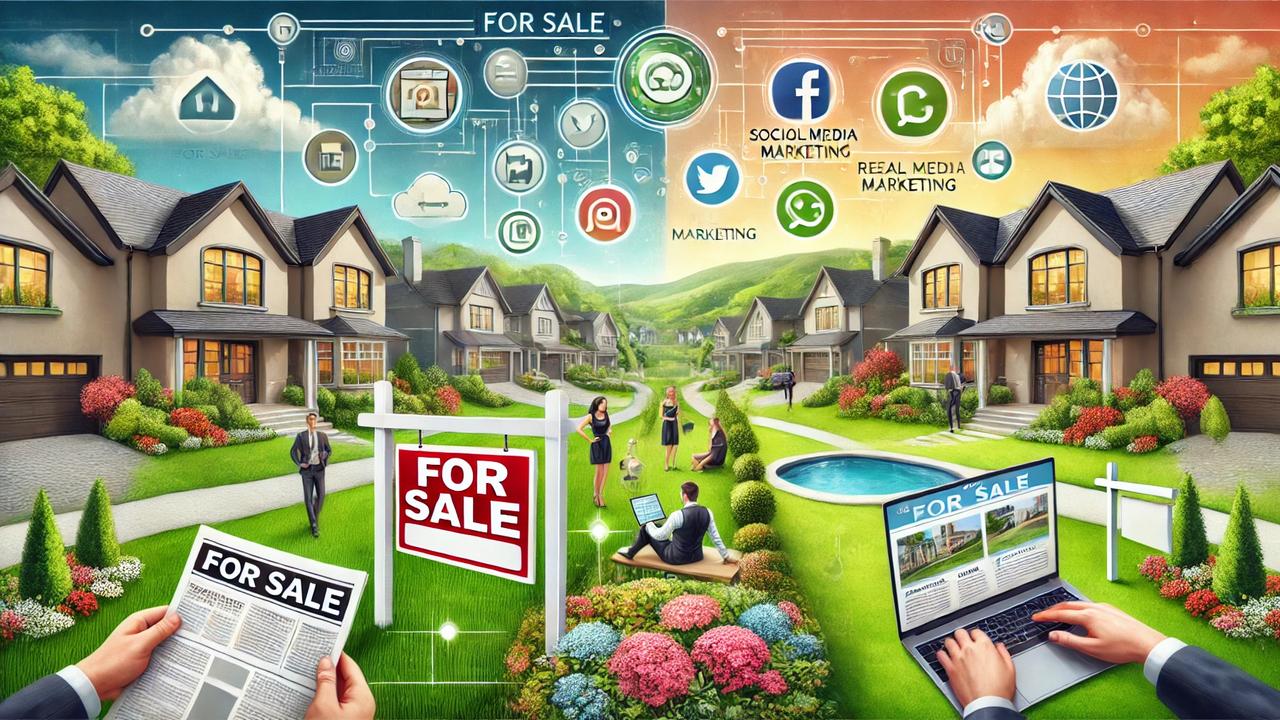
When it comes to marketing your property, choosing the right strategy can make all the difference. The real estate industry has evolved significantly, offering various methods to reach potential buyers. Traditionally, real estate agents relied on physical marketing techniques, but the digital revolution has introduced targeted approaches. Understanding the pros and cons of traditional and digital methods will help sellers maximize their reach and achieve better results.
This article will provide an overview of marketing your property in comparison to traditional vs. digital methods.
Traditional Marketing Strategies
Before the rise of the internet, traditional marketing methods dominated the real estate industry. These techniques still hold value and can be effective, depending on the target audience and market conditions.
1. Print Advertising
One of the oldest real estate marketing strategies, print advertising includes newspaper listings, flyers, brochures, and magazine ads. Local newspapers remain a popular choice for advertising properties, as they attract serious buyers looking for homes in specific areas. However, print media has limitations in terms of reach and cost-effectiveness.
2. Open Houses and Property Showings
Hosting an open house is a time-tested way of marketing your property. This method allows potential buyers to tour the property, visualize themselves living there, and ask questions in real time. While effective, open houses require significant preparation and may not always attract serious buyers.
3. Word-of-Mouth and Referrals
Many property deals occur through personal networks. Sellers often rely on referrals from friends, family, and real estate agents to find potential buyers. While this method builds trust, it limits the audience and may take longer to secure a sale.
4. Signage and Billboards
“For Sale” signs placed on the property and billboards in strategic locations can generate interest from passersby. This method works well in high-traffic areas but lacks the ability to target specific buyer demographics.
5. Direct Mail Campaigns
Sending postcards, letters, or brochures to targeted neighborhoods can generate leads. While direct mail offers a personal touch, it can be costly and may not yield high conversion rates compared to digital alternatives.
The Rise of Digital Marketing for Real Estate
As technology advances, digital platforms provide real estate sellers with powerful tools to attract buyers. Digital marketing for real estate is now essential in maximizing visibility, engaging with potential clients, and speeding up the sales process.
1. Social Media Marketing
Platforms like Facebook, Instagram, and LinkedIn have transformed property marketing. Sellers can showcase listings through high-quality images, virtual tours, and video walkthroughs. Social media ads also allow precise targeting based on location, interests, and demographics, increasing engagement and potential inquiries.
2. Real Estate Websites and Online Listings
Websites like Zillow, Realtor.com, and local MLS platforms provide extensive exposure to potential buyers. Listing a property on these platforms ensures it reaches a wider audience, including buyers from different cities or even countries. High-quality photos, detailed descriptions, and virtual tours enhance the appeal of the property.
3. Email Marketing Campaigns
Email remains an effective way to nurture leads and keep potential buyers informed about new listings. Sending newsletters with featured properties, market insights, and special promotions helps maintain engagement and increases the likelihood of closing a deal.
4. Search Engine Optimization (SEO) and Pay-Per-Click (PPC) Advertising
Optimizing property listings with relevant keywords improves their visibility on search engines like Google. Additionally, PPC ads allow sellers to reach buyers actively searching for homes, ensuring that marketing efforts target high-intent audiences.
5. Virtual Tours and 3D Walkthroughs
Technology has revolutionized property viewing. With 3D tours and virtual walkthroughs, buyers can explore properties from the comfort of their homes. This feature enhances engagement, saves time, and attracts serious buyers who have a genuine interest in the property.
Comparing Traditional and Digital Marketing
To determine the best approach for marketing your property, it is essential to compare the strengths and limitations of traditional and digital marketing methods.
| Aspect | Traditional Marketing | Digital Marketing |
|---|---|---|
| Reach | Limited to local buyers | Global reach with online platforms |
| Cost | Higher due to printing and physical ads | More cost-effective with targeted ads |
| Engagement | One-way communication | Interactive and data-driven marketing |
| Speed | Slower, depends on word-of-mouth | Faster response through instant online inquiries |
| Flexibility | Difficult to modify | Easy to update and optimize campaigns |
Choosing the Right Strategy
The best approach to marketing your property depends on your target audience, budget, and urgency to sell. A combination of both traditional and digital marketing methods can yield the best results. Here are a few property marketing ideas to enhance your strategy:
- Use high-quality visuals: Whether for print or online listings, professional photos and videos increase buyer interest.
- Leverage social media ads: Target potential buyers using Facebook and Instagram ads with compelling content.
- Host virtual open houses: Engage buyers who may not be able to visit in person.
- Create a dedicated property website: Showcase detailed information, images, and contact details in one place.
- Partner with real estate influencers: Increase exposure through collaborations with digital personalities.
Conclusion
Both traditional and digital marketing methods play a crucial role in selling real estate. While traditional techniques provide credibility and local reach, digital marketing for real estate offers broader visibility, cost-efficiency, and faster results. By integrating both approaches, sellers can maximize their chances of securing a sale quickly and efficiently. Whether through social media, search engine optimization, or open houses, the key is to stay adaptable and utilize strategies that align with the latest market trends.






Leave a Reply
You must be logged in to post a comment.